uzbek ensi ?
Bonsoir à tous
The discussion about the Filiberto's mystery rug oriented me to search about
Uzbeks weavings in Hali.
In the Hali issue # 116, page 149, in an article about the San Francisco Arts
of Pacific Asia Show, there was a little picture of an Uzbek ensi (Anthony Hazeldine
from Fairford).
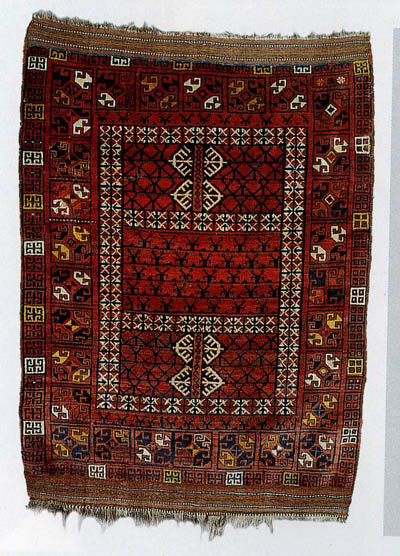
I did not know that Uzbeks made also ensis and it was the first one I saw as
Uzbek. But this was not the first I had seen of this design. In fact I had in
my stock a fragmented ensi that I thought just to be a bizare ersari, but with
a design quite near of the Hali example.

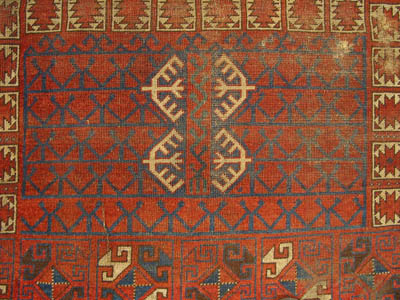
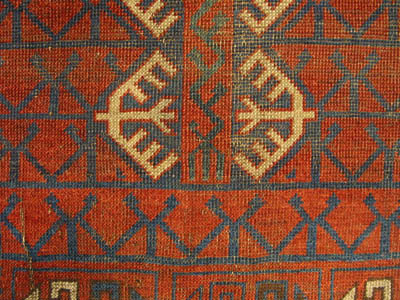
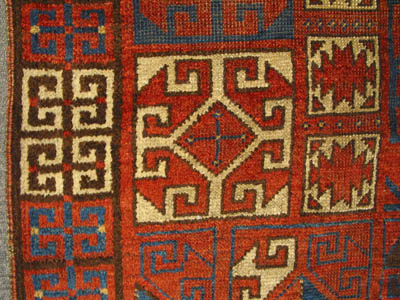
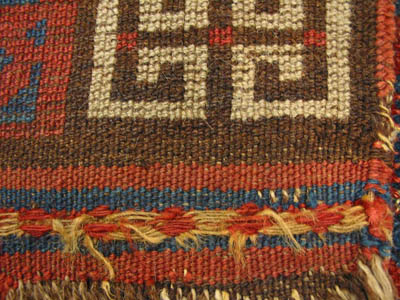
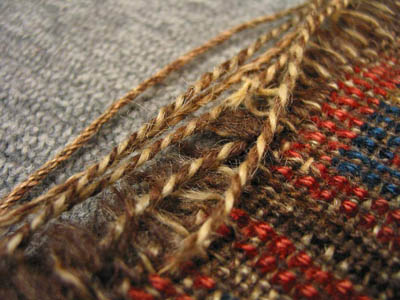
This rug is fragmented and shows fondation by places. Where the pile is low
but good the wool is very silky. True colours are a little less vivid than on
the pictures.
Width about 165 cm, estimate real length about 200 cm. Dimensions near of a
great ersari ensi.
Knots assymetric open to the left
Warps : beige, brown wool
Wefts : brown
No depression
Knot count : H 22/10cm V 30/10cm
Colours : one dark brick red (madder), 2 blues, one dark green, one brown (maybe
undyed), one ivory (undyed wool)
The selvedges seem quite complete and are wrapped with red wool with two cords
of pepper and salt wool. This is not a typical ersari detail. The hali example
seems to have also this type of red selvedge.
Parts of a remaining stripped kilim at one end; There is a similar kilim in
the Hali example.
In the design, compared with more classical ensi of the Ersari we can notice
the giant Bovereks and the very curious variant of the candelabras/kuch motifs.
When I bought this piece I thought that it could be a late ersari variant, cut
off from its stylistical roots (a modern 1925 form, influenced by occidental
design by ex.).
There is in Jourdan, plate 247 page 274 an ensi with the same giant Boverek,
it is described as Ersari.
I do not know any other publicated example of this curious design and I would
be very glad to find some other evidences of the Uzbek origin of this rug.
amicales salutations à tous
Louis
Posted by Steve Price on 02-03-2006 06:00 AM:
Hi People
The images are now in Louis' post.
Steve Price
Posted by R. John Howe on 02-03-2006 06:30 AM:
Louis -
An interesting find. I think the treatment of the center four-panel with cross
piece ("hatchli") section is quite unusual.
Note also that the main border device is the same (less the surrounding Memling
gul) as that on the little rug Filiberto picked up for me and that we have discussed
a bit in another thread.
![]()
Regards,
R. John Howe
Posted by Fred Mushkat on 02-03-2006 03:47 PM:
Hello all,
The main border design is an interesting one that has a great history. It can
be viewed as an octagon within which is a diamond enclosing a cross. Alternately,
it can be viewed as four diagonally facing red icons with the elibelinde design,
the much dscussed so-called 'hands on hips' symbol. A third way to look at that
design is to view it as a white diamond from which eminate latchhooks in the
four cardinal directions. This design is also known as a 'cloud collar' and
has deep roots in Chinese art, and which appears in old Turkmen, Anatolian,
and Iranian weavings, metalwork and pottery. It is my opinion that the intent
of the design is to display the cloud collar. Bruggeman and Boehmer discuss
this symbol extensively in their landmark book on Anatolian rugs. There is also
a discussion of this in John Wertime's book, Soumac.
Posted by louis_dubreuil on 02-04-2006 12:49 PM:
Kaikalak motif
Bonjour Fred, bonjour John
There is in the Peter Stone's book a good analysis of the motif that we can
see in the main border of the ensi and on the inner device of the memling gul
of the Filiberto's rug.
This motif is named by Stone : KAIKALAK. In Tzareva's book Kaikalak is said
to come from kirghize with the maining of IMAGE or IDOLE, or CURVED.

One of the caracteristics of the art of the weaving design is to play with positive/negative
forms. This is very well used in anatolian kilims. An other description way
is to speak of reciprocated forms. The Kaikalak motif can be plaid in postive
or in negative way, as Stone says in his book.

The motifs can be associated in lines and columns in order to fill a field or
a border of a rug, as we can see in the ensi or in the Stone schema :
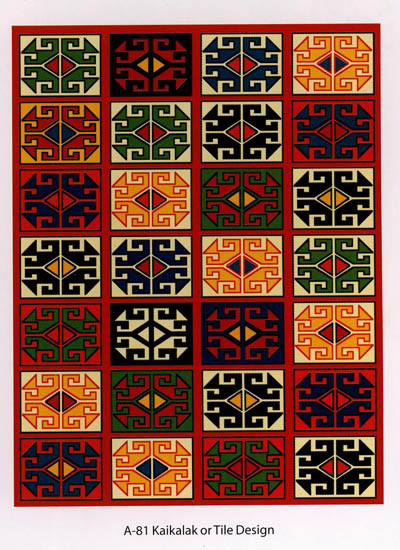
We have the same thing in the Filiberto's rug. The device we can see in the
Memling gul is a Kaikalak form, but here it is curvilinear.

We can see also the same graphic mechanism in a beluch bag described by Opie.
In this design we can see an other graphic transformation of a device : the
little triangle added by the weavers in one of the branche of the negative form
of the Kaikalak gives to this branche a look of an animal head. I think it is
a great tendancy for certain weaving tribes to "animalise" forms that are on
the origin only geometrical forms as the Kaikalak motif. As J. Opie in his thesis
has a tendancy to see animal heads anywhere he sees the negative form of the
kaikalak as an animal symbol. I do not think this is the base of this design.
The medalion of the balouch bag has also its positive form of a flatened kaikalak
motif :
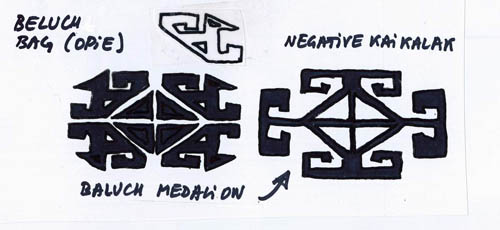
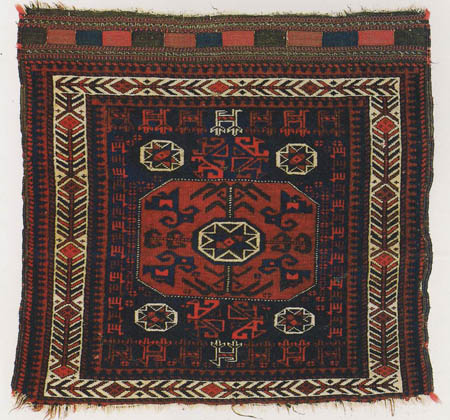
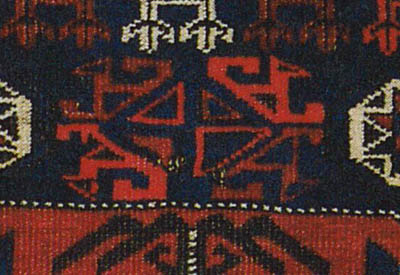
I do not agree with the cloud collar hypothesis for explaining this motif and
some derivated others. The transformation is too complicated (in french : tirée
par les cheveux). The kaikalak formation is more sipmle in my opinion : we have
just to take the koçboynuzu/rams horn symbol (certain authors can see in it
a very old symbol they call BIRTH SYMBOL, made by a lozange with for hooked
devices) and to duplicate and rotate it. This graphic transformation is very
common in weaving motifs (double symetry).
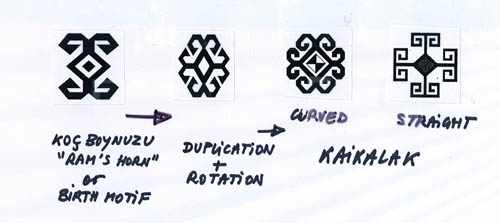
If we combine four kaikalak motifs under their negative form we can see in the
middle a new form made by the combination of the negative forms attached by
an other side. This new form is a well known one because this is a kind of gul
we can see in many diferent weaving regions (anatolia, caucasus, azerbaidjan,
beluch area, shasavan...).

Wertime in his book about sumak bags describe it as TOKME GIYNAKH (shasavan
language) (in english shed talons).
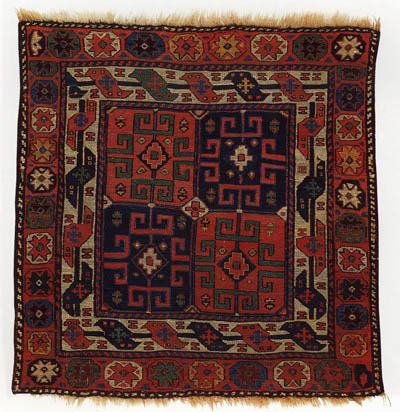
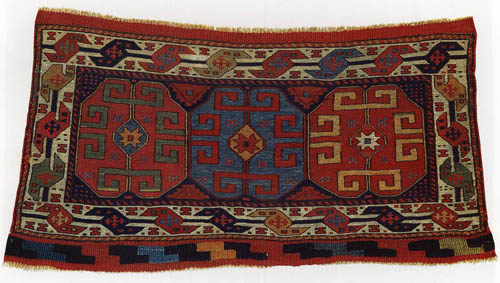
Wertime also speaks about the cloud collar hypothesis for explaining the origin
of this design. I this the kaikalak hypothesis is sufficient.
We can see similar device in numerous baluch rugs. Opie describes one beautiful
rug with this design where the TG devices are arranged in totem like columns
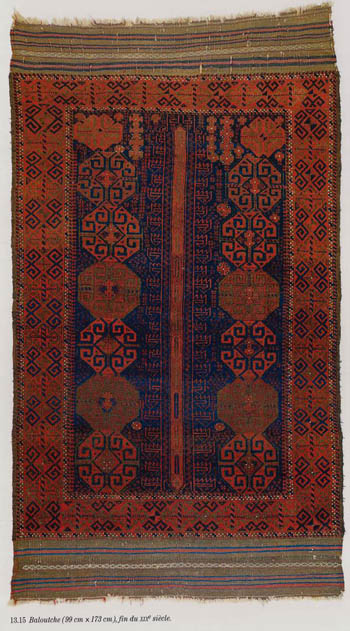

The construction of the column and the disposition of the two adjascent TG devices
with their two pairs of hooks has oriented the weaver to make at the jonction
line between the two TG a lozangic form. She puts in evidence here a new ramshorn
motif that would be less visible if there was not the lozange between the two
pairs of hooks.
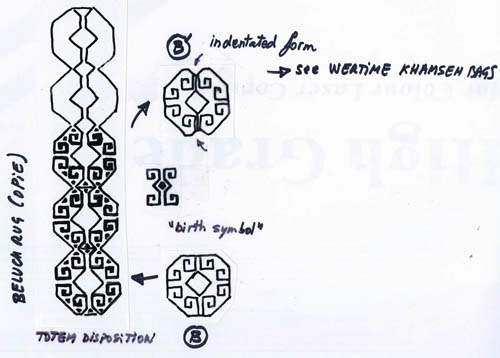
It is remarquable that the TG design, on other weavings has always the indented
form at the base and at the top (never on the sides). We can may be make the
hypothesis that this device derivated from the kaikalak has been fixed in the
rug vocabulary after being TOTEMISED. It has then kept the indentation in the
folowing uses, even non totemic (see wertime's khamseh bags.
Just for an example see the picture of this Talish rug that shows a flattened
form of the TG device. Some of them are drawn with the hooks in the bad directions
(this is a common feature in this design in all tribes).
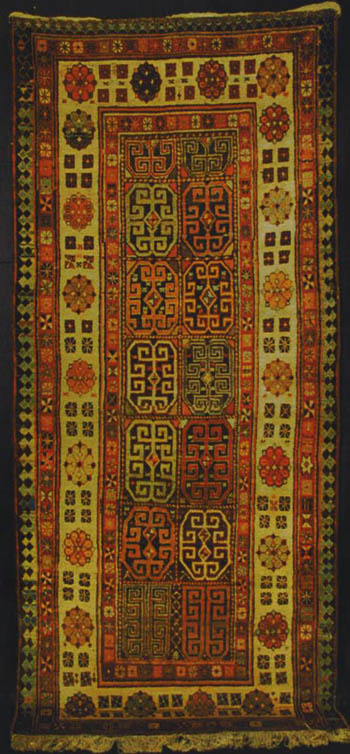
That's all folks.
Meilleures salutations
Louis
Posted by louis_dubreuil on 02-04-2006 02:55 PM:
kaikalak
First info
There is no evidence of the uzbek origin of the Hali ensi. Mr Hazledine said
me this was just a guess based on his experience about this region. I suppose
the palette of his rug with the yellow devices in the kaikalak border oriented
him toward the uzbek hypothesis. No technical datas.
There is no similar published ex. So, if somebody can find a documented similar
ex....
Second info
After sending my post I was in a supermarket. Waiting my tour for paying I was
thinking to the Kaikalak motif. In fact the Tzareva translation of the kirghize
word can have a real meaning adapted to the dual reading of this design : fisrt
"image or idol" : this could be applied to the negative devices (they really
look like little elibelindes, is'nt it), second "curved" : this fits very well
with the positve hooked shapes. To be explored....
A plus
amicales salutations
Louis
Posted by James Blanchard on 02-04-2006 09:24 PM:
Bonjour Louis,
Thanks for the interesting design analysis. I enjoyed it...
In another thread, Filiberto has presented a "Mystery Small Rug" that some have
suggested is Uzbek (http://www.turkotek.com/VB22/showthread.php?s=&threadid=1438&pagenumber=1).
It seems to have that similar design motif, the "Kaikalak" that you have referenced
from Stone's book. In my uneducated musings I had connected it to other Uzbek
designs from their embroidered work. It seems that connection has been made
before by Stone, and you have noted it again here. Here are the examples I was
referring to. Then again, perhaps it is the product of an overactive imagination
James.
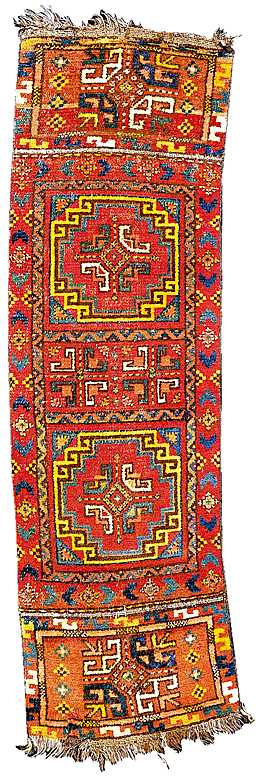
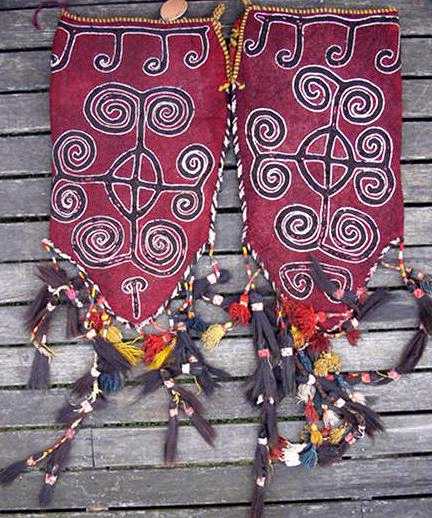

Posted by Filiberto Boncompagni on 02-05-2006 04:39 AM:
Very nice study Louis, 
You shed a new light on this gul and its variations.
I hope you checked your change at the Supermarket, though. 
Regards,
Filiberto
Posted by louis_dubreuil on 02-10-2006 07:13 AM:
uzbek ?
I have made a research in my archived pictures taken from the net (Ebay, cloudband...)
in the ensi file. I have found some ensis that feature the kaikalak main border
device and an other "ensi" that was labelled as "uzbek rug". For this uzbek
rug I do not remember where I have found it. If somebody remember where was
this rug (ebay, gallery Cocoon...) maybe I could contact its owner in order
to get some tech. datas about it.
Ensis with kaikalak main border and listed as ersari ones :
This one (ensi A) has an unsusual format of 112x188 cm. The Kaikalak design
is also used in the central horizontal bar
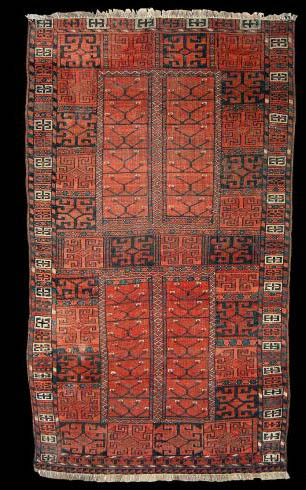
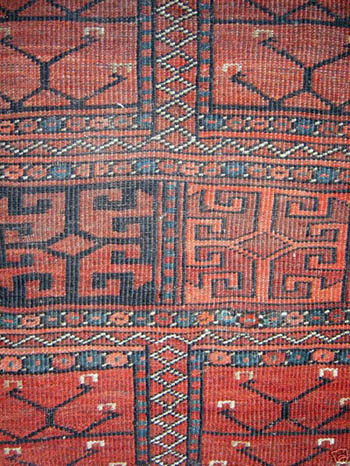
This one (ensi B) mesures 132x167 cm.

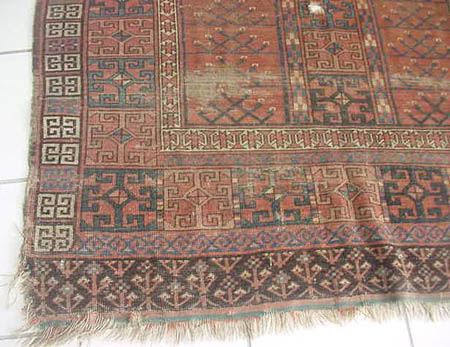
This one (ensi C) mesures 132x191. The kaikalak motif is a variant with the
axes of the device turned at 45 degrees
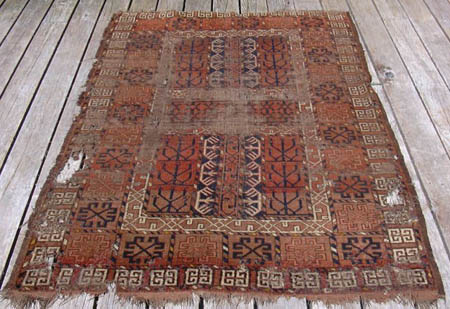
This one (ensi D) features just a Kaikalak bar in the upper part of the elem,
and mesures 132x189 cm

This one (ensi E) shows a main border with a variant of the kaikalak that doesn't
use the positive/negative feature (135x 183 cm)
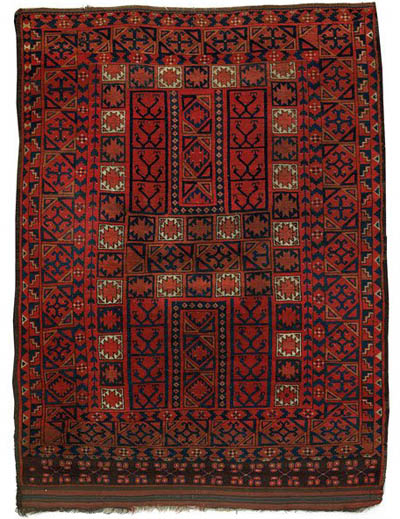
This ensi (ensi F), described as ersari in Jourdan's, shows boverek and kush
motifs with a design near of the so called uzbek ensis. There is no kaikalak
border . It is a very litlle rug (101x127)compared with others.
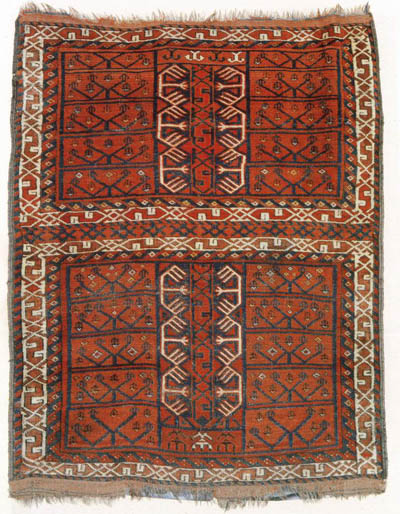
And this piece (below left, Ensi G) was described by the seller as "uzbek" rug
(181x254 cm).
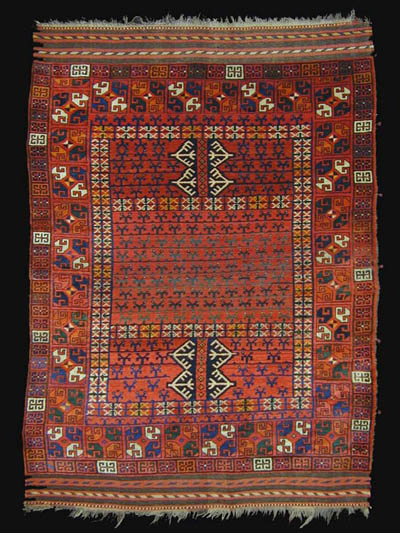

This one is near of the uzbek ensi from Mr Hazledine (above right, unknown dimensions,
ensi H). The field design is of the same family of pseudo kush. The kilims at
the ends have an really uzbek look, the palette is also "uzbekoid". The same
design is shared by my ensi fragment (ensi I, see below)

We can make homegeneous groups, based on shared design :
one so called "uzbek" group with ensis G,H,I with similar field devices, kaikalak
border and special bovereks.
one we can name "pseudo uzbek" group with ensis C and F with quite similar field
design and same boverek design (one without kaikalak and one with kaikalak variant)
one with kaikalak borders and bars but with no boverek and with classical ersari
field design (A, B)
one with kaikalak on the elem and quite near special boverek but with classical
field (D)
one without special design that looks classical ersari (E)
We can guess that A, B, E could be all ersari.
The question remains : do uzbek make real functional ensis for their yurt ?
And in this case we can guess that C, D, F, I (though its dimensions are a bit
large - 165x200) could be real ensis.
Dimensions of the G ensi seem too large to fit with an ensi. We do not know
the dimensions of the H ensi, but its design and proportions seem to be near
of the G, so we can gess its dimensions would be near of G. Could we be in this
case (G, H) of really uzbek products but made as copies of genuine ensis for
commercial "carpet" purpose ?
Meilleures salutations à tous
Louis Dubreuil
Posted by louis_dubreuil on 02-11-2006 11:11 AM:
knots
Bonjour à tous
New precisions about ensis H et I
Ensi H, is described as having assymetric knots open to the RIGHT. You can see
this rug with more details (view of the back)on the site of Barry O'Connell
SW-ASIA.com, turkmen dictionnary, ensi. The rug is from Cocoon Gallery.
I have verified again, the ensi I has assymetric knots open to the LEFT with
warps in the same level ( As 1).
Tzareva in her book (Tapis d'Asie centrale et du Kasakhstan) describes 5 uzbek
carpets (# 116, 117, 118, 119, 120) : 3 are As1, 2 are As IV (assym, open to
the right and warps not on the same level).
We lack of matter for having a good view of what is the typical Uzbek weaving
style.
Bon week end à tous
Louis
Posted by louis_dubreuil on 02-13-2006 11:08 AM:
an other uzbek ensi
Bonjour à tous
Searching to reach the Turkotek salon about ensis, I have wrote engsi on Google
search engine and I have found an archived post from John Howe about an ensi
he had seen at ICOC X exhibition (rug # 57)

This rug displays exactly the same design with a more coloured kaikalak border.
It could be interesting to have more technical datas about this rug (dimensions,
knotting...) If John could have taken some notes.....
Meilleures salutations à tous
Louis
Posted by louis_dubreuil on 02-13-2006 12:01 PM:
three + one
In order to have a better view of the diferent so called "uzbek" ensis, I have
put the pictures together on the same screen.




Posted by R. John Howe on 02-14-2006 05:05 AM:
Dear folks -
Kelvin Webb, who collects mostly non-Turkmen Central Asian pieces has sent two
images of the engsi below:

Here is the back:
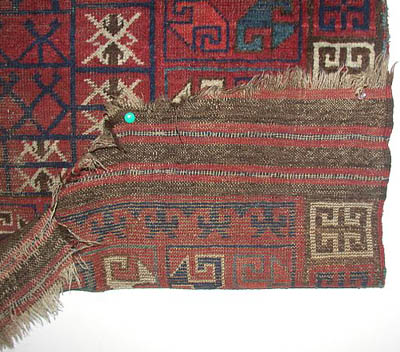
He included the following technical information and comment:
Uzbek Ensi
78 x 62 inches
open left
two shots of weft
6V x 6H
2 cord selvedge
Floppy handle
The lighter red is a red; not orange as in most.
Believe this is earlier than most that have been posted
Thanks, Kelly,
R. John Howe
Posted by louis_dubreuil on 02-14-2006 09:44 AM:
new ensi type
bonjour John
The missing Robert Pinner said in "Turkoman studies I", about a curious Tekke
rug, " a carpet with an unfamiliar pattern creates a problem ; a second creates
a type." I think we are here.
We have now five very near rugs with the same design. Those rugs have an "ensi"
look. This ensi look is due to :
- central quartered field with horizontal bar separated from the field by two
borders and vertical pole ornamented with bovrek motifs
- pannels of the central field divided into horizontal bands ornamented with
geometric repetitive black devices that can be interpretated as a variant of
the traditionnal kuch motif shared by numerous types of ensis from diverse tribes
- outer border ormamented with sainak motifs
- main border made of repetitive kaikalak motifs that can be found on some Ersari
ensis.
But, in three of the five rugs described here, the main caracteristic that separates
a real ensi from a carpet - the lower elem- is lacking. Only two of the examples
( the last rug posted by John - from Mr Webb- , and mine) show a typical architecture
with borders not running all around the field (PI design) that can really show
how to orientate the rug as a door rug. Those two examples have a reduced lower
elem made with a simple line of kotchak motifs. Those two have quite similar
dimensions (157x198 for John's, 165x about 200 for mine). We have just the dimensions
of one of the four other (181x254 for Cocoon's ex.) and it seems lightly out
of the range for being a real ensi.
Those three rugs show also an equal kilim band at the two ends : ensis generally
have just a kilim band at the lower end, the upper end kilim being folded and
sewn to reinforce the upper end for hanging. We do not have evidence that the
two others have or have not a folded kilim on the upper end.
I think this five rugs group can be devided in two groups :
- one group of two (Web's and mine), that seem also to be the older ones, which
can be interpretated as real ensis and can be related for design reasons to
two other so called "ersari" ensis (ensi C and F - bovrek and kuch motifs- ).
Their Uzbek attribution has to be proved with more precise evidences.
- one group of three (G, H, #57 from ICOC X) that seem to be more carpets than
real ensis, with an homogeneous design that could be copied from real ensis
models and that seem more recent. Their palette seem also more Uzbek than Ersari.
We can put an other question about Uzbeks : turkmen or non turkmen group. There
are apparently two diferent groups of Uzbeks : one, the larger, of turkick origin
but not apparented to the Oghuz ancestors, one other, smaller, named by Moshkova
"Tukmen Uzbekis", historically linked to the Turkmen and with somes aspects
of material culture that suggest a Turkmen origin (Oriental carpet, a complete
guide, M. Eiland, page 253). Those Turkmen Uzbeks lived in the vicinity of Nurata.
they are known for a XIX° century production of piled rugs.
Maybe this is this group who has made those ensis and pseudo-ensis dicussed
here.
Meilleures salutations à tous
Louis dubreuil
Posted by louis_dubreuil on 02-22-2006 07:53 AM:
Last news
Bonjour à tous
In ORR vol 10, # 6, aug/sept 1990 I have found an Ersari ensi that could be
related to two of the ensi exposed in this thread (ensi C and ensi F).
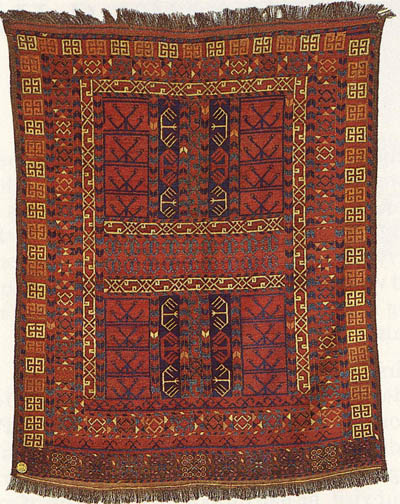
This last ensi is from the Meyer-Muller collection and was sold at Christie's
auction (september 1990, 11th sale). This ensi is highly related to the F one,
diplayed in Jourdan's book.

This one is curious because the only relation with classical ensi design is
its shape looking as a central field of an ensi. This first impression is confirmed
with the meyer-Muller ensi : the central field of this last one has exactly
the same design than the Jourdan's, even for the borders (same thing for the
C ensi).
This fact can make us interogated by the real signification of the Jourdan's
: does this rug have been made like that just to copy the central field of a
real ensi ? Or does this rug be a forgery made with a fragmented remain of an
ensi on witch kilim ends would be added in order to make think to a complete
and original rug ?
The second conclusion we can make with this ensi is that we have confirmation
of an "ersari" type which dispays special kuch motifs with a third vertical
bar in the middle of the W shape and special hudge and angular bovrek motifs
(see ensi C below).

Ensi I, and the Webb's one can also classified in a related group with central
panel's motifs being always read as kuch, the bird's head being still here (but
less distinctly drawn).


This ersari type could possibly be the model for Uzbek weavings : quite near
giant Bovrek and pseudo kuch with always the third vertical bar.
The Uzbek "pseudo ensis" could be commercial products sold as carpets. The pseudo
kuch motifs in the Uzbek products no longer look like "birds" but are only geometric
shapes, maybe because the meaning and symbolic "bird" representation was completly
lost (or stranger for) by the one who made the copies, or because there could
be a "taboo" about representation of animals among the weavers who made the
copies.







































